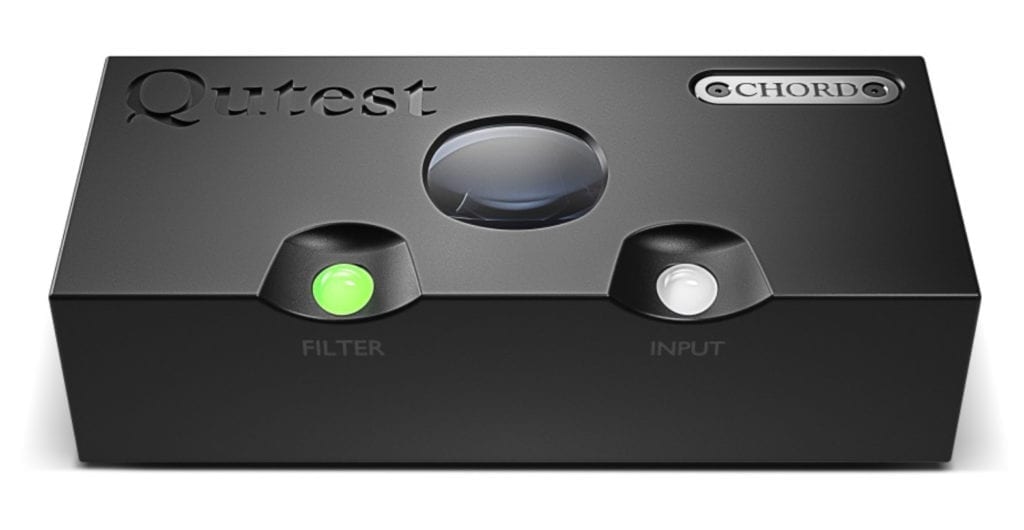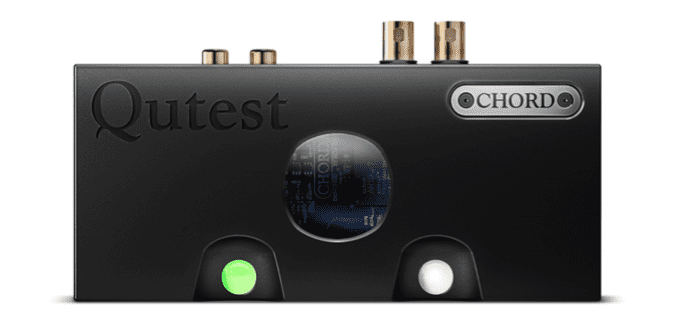Chord Electronics launches the world’s most advanced compact DAC: introducing Qutest
Qutest sets a new technical benchmark for a small, home system digital-to-analogue convertor
Pricing is £1,195 inc VAT
9th January 2018, CES, Las Vegas: Chord Electronics has launched the most advanced compact DAC on the planet: Qutest. A highly accomplished standalone device, the new Qutest is based on the latest proprietary Rob Watts’ FPGA technology developed for the class-leading Hugo 2 DAC/headphone amp. Qutest uses an all-new precision-machined aluminium chassis and includes several new features, including fascia controls.
Qutest uses the same award-winning internal DAC architecture and proprietary software coding as the Hugo 2, giving it proven class-leading technical and sonic performance. Qutest also offers Hugo 2’s unique user-selectable frequency-shaping filters and input selection controls, available via two fascia-mounted spheres, introducing useful flexibility. Qutest offers a significant cost saving over Hugo 2 (H2 £1,800), as it eschews the headphone amplifier, rechargeable Li-on batteries and crossfeed functionality integral to the transportable device.
Qutest is the latest evolution of Chord Electronics’ most affordable standalone DAC, the multi-award-winning 2Qute, which it directly replaces. Qutest is uniquely equipped to bring the benefits of Chord Electronics’ acclaimed proprietary hardware and software
technology to a wide range of connected devices. It features a galvanically isolated USB-B, optical and dual coaxial digital inputs, giving an instant upgrade to everyday audio devices plus the ability to modernise ageing digital source components. It also features RCA analogue outputs for connection to integrated amplifiers, preamps and headphone amps, plus high-resolution 768kHz-capable dual-data digital inputs for connection to Chord Electronics’ devices including the 705/768kHz-ready M-Scaler-technology BLU MKII digital/ CD transport.
Future-proof: High-Res Audio to 768kHz PCM/DSD 512
Qutest has been designed for static use within home audio and desktop hi-fi systems. The new design benefits from 5V Micro USB powering which offers improved flexibility over its predecessor. Qutest offers support for up to 32-bit/768kHz PCM and DSD512 via its galvanically isolated USB-B input, 24-bit/384kHz PCM and DSD128 via coaxial (BNC) and 24- bit/192kHz data on Optical TOSLink. DSD 64 to DSD 256 is supported via DoP and ASIO native DSD format is also supported up to 512.
The device features a Class 2 USB input which, because of the Qutest’s home-system orientation compared to Hugo 2’s more mobile aspirations, has been galvanically isolated. This has been achieved using a novel technique which allows for very high data rates of up to 768kHz; the input is driverless on Apple and Android devices, with (ASIO included) drivers for Windows devices.
All-new aluminium casework
The Qutest chassis is all-new. It has significantly greater mass than its predecessor and has been precision-machined from solid aircraft-grade aluminium billet. The Qutest PCB nestles within a shallow cavity in the solid aluminium chassis, giving the circuit board greater protection within the casework and additional isolation from external vibration compared to previous designs.
Qutest’s new square-edge chassis design created by owner and Chief Designer John Franks retains the popular circular magnifying porthole window, which reveals the custom Chord Electronics’ circuit board within. Qutest’s control spheres (for user-selectable frequency- shaping and input selection) illuminate with useful colour-coding information denoting sample frequency and filter used; brightness settings are user-adjustable. A further new feature is a user-selectable output voltage available in 1, 2 and 3V RMS outputs for flexible connectivity with partnering devices.
New levels of technical performance for a compact DAC
The latest FPGA and advanced WTA (Watts Transient Aligned) filters have been implemented in the Qutest, bringing a wide variety of performance improvements over the 2Qute in a number of areas. Performance gains have been made in timing accuracy, noise reduction and dynamic range and tap length, the technical indicator of how complex the interpolation filter is, has more than doubled compared to its predecessor, to 49,152.
User-selectable filtering option
A four-function switch filter, operated by its own control sphere, offers a useful degree of user-selectable frequency-shaping, bringing warm and soft or transparent and incisive presentations, giving additional flexibility and user control.
Technical specifications
Frequency response: 20-20 kHz +/- 0.2dB Tap-length: 49,152 Dynamic range 124 dB AWt THD: 0.0001% 1 kHz 2.5V RMS 300 ohms THD and noise at 2.5v RMS ref 3V: -117dB 300 ohms AWt Channel sep 138 dB at 1kHz 300 ohms
Galvanically isolated USB No measurable noise floor modulation Inputs:
1x Optical TOSLink 24-bit/192kHz-capable 2x BNC coaxial input 24-bit/384kHz-capable (dual data mode up to 768kHz for M-Scaler operation)
1x HD galvanically isolated USB-B input 32-bit/768kHz and DSD512-capable
Outputs: 1x (pair) stereo RCA phono outputs: 1, 2 and 3V RMS
Price and availability
Qutest is available to order now (black only) from Chord Electronics dealers priced at



